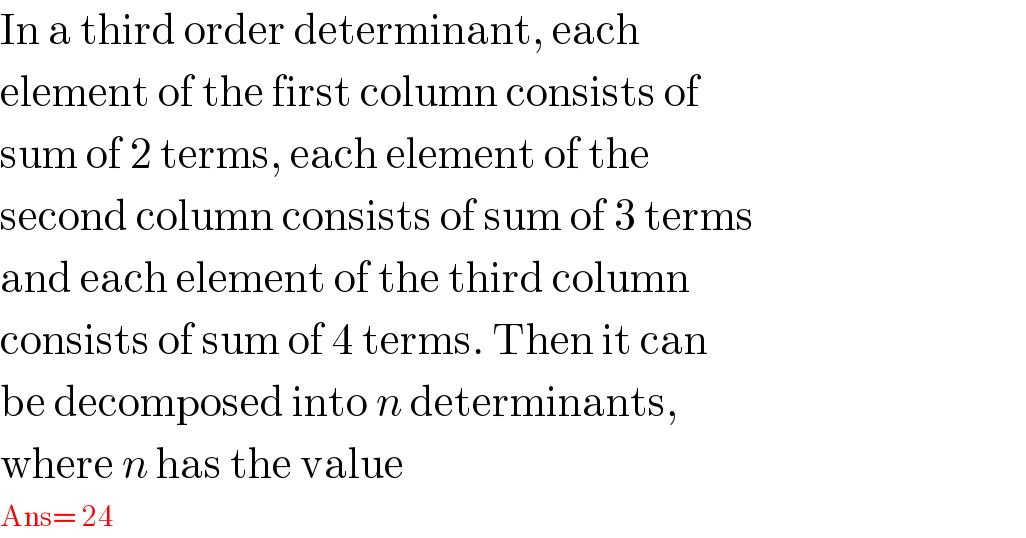
Question Number 15158 by arnabpapu550@gmail.com last updated on 08/Jun/17

$$\mathrm{In}\:\mathrm{a}\:\mathrm{third}\:\mathrm{order}\:\mathrm{determinant},\:\mathrm{each} \\ $$$$\mathrm{element}\:\mathrm{of}\:\mathrm{the}\:\mathrm{first}\:\mathrm{column}\:\mathrm{consists}\:\mathrm{of} \\ $$$$\mathrm{sum}\:\mathrm{of}\:\mathrm{2}\:\mathrm{terms},\:\mathrm{each}\:\mathrm{element}\:\mathrm{of}\:\mathrm{the} \\ $$$$\mathrm{second}\:\mathrm{column}\:\mathrm{consists}\:\mathrm{of}\:\mathrm{sum}\:\mathrm{of}\:\mathrm{3}\:\mathrm{terms} \\ $$$$\mathrm{and}\:\mathrm{each}\:\mathrm{element}\:\mathrm{of}\:\mathrm{the}\:\mathrm{third}\:\mathrm{column} \\ $$$$\mathrm{consists}\:\mathrm{of}\:\mathrm{sum}\:\mathrm{of}\:\mathrm{4}\:\mathrm{terms}.\:\mathrm{Then}\:\mathrm{it}\:\mathrm{can} \\ $$$$\mathrm{be}\:\mathrm{decomposed}\:\mathrm{into}\:{n}\:\mathrm{determinants}, \\ $$$$\mathrm{where}\:{n}\:\mathrm{has}\:\mathrm{the}\:\mathrm{value} \\ $$$$\mathrm{Ans}=\:\mathrm{24} \\ $$
Commented by 1kanika# last updated on 07/Jun/17

$$\mathrm{n}+\mathrm{1}\:\mathrm{may}\:\mathrm{be} \\ $$
Commented by arnabpapu550@gmail.com last updated on 08/Jun/17

$$\mathrm{But}\:\mathrm{its}\:\mathrm{answer}\:\mathrm{is}\:\mathrm{24} \\ $$
Commented by prakash jain last updated on 08/Jun/17
![2×3×4 e.g [((a+b),(c+d)),((e+f),(g+h)) ] = [(a,(c+d)),(e,(g+h)) ]+ [(b,(c+d)),(f,(g+h)) ] = [(a,c),(e,g) ]+ [(a,d),(e,h) ]+ [(b,c),(f,g) ]+ [(b,d),(f,h) ]](Q15269.png)
$$\mathrm{2}×\mathrm{3}×\mathrm{4} \\ $$$${e}.{g} \\ $$$$\:\:\begin{bmatrix}{{a}+{b}}&{{c}+{d}}\\{{e}+{f}}&{{g}+{h}}\end{bmatrix} \\ $$$$\:=\:\begin{bmatrix}{{a}}&{{c}+{d}}\\{{e}}&{{g}+{h}}\end{bmatrix}+\begin{bmatrix}{{b}}&{{c}+{d}}\\{{f}}&{{g}+{h}}\end{bmatrix} \\ $$$$\:=\:\begin{bmatrix}{{a}}&{{c}}\\{{e}}&{{g}}\end{bmatrix}+\begin{bmatrix}{{a}}&{{d}}\\{{e}}&{{h}}\end{bmatrix}+\begin{bmatrix}{{b}}&{{c}}\\{{f}}&{{g}}\end{bmatrix}+\begin{bmatrix}{{b}}&{{d}}\\{{f}}&{{h}}\end{bmatrix} \\ $$
